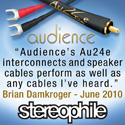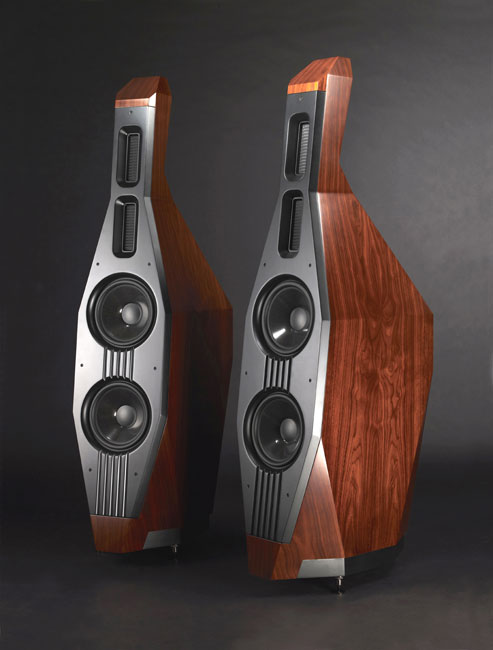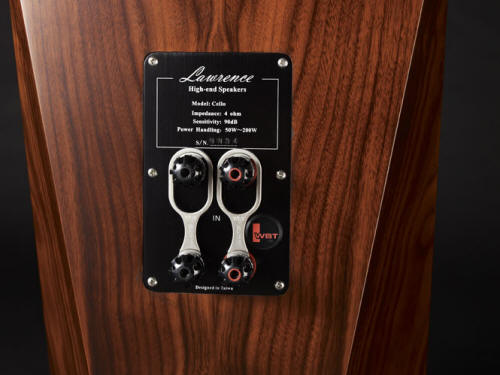|
|
You are reading the older HTML site
Positive Feedback ISSUE 62
lawrence audio Cello Loudspeakers as reviewed by Gary Lea
As I mentioned last year in my review of the Lawrence Audio Violins, Lawrence Audio is not a house hold name in American audiophile circles, at least not yet. With the addition of the Cello floor standing speaker to the mix this could really accelerate their presence here. From last year's review: "I ran into Lawrence Liao & Angela Yang from Lawrence Audio at the 2011 CES and was drawn into the room by the sounds that were emanating. It takes a bit to draw me into any room not on my short list of rooms to visit. Suffice it to say I was impressed enough to venture in to the room and certainly enamored enough to stay and visit for a while. Most of my conversation was with Angela as her English was far better than my Cantonese or Mandarin. Lawrence is the designer of all of the components in his line. In addition to speakers he also designs amplifiers and preamplifiers. Before I left the room we had the discussion that led to this review. It did take approximately 7 months before the speakers were delivered but when they arrived it became quickly apparent that it was worth the wait." At the end of the 2012 CES I found myself driving home with an SUV full of The Lawrence Audio Cello speakers. Just as eye catching stand mount, two way speaker. The Cello cabinet design does mimic the shape of a cello, again in that sort of surreal, Dali meets Frank Lloyd Wright way. Finished in a lacquered Rosewood and black paint finish, they are quite attractive and still maintain the relatively small in foot print of the Violins just in a taller package.
Associated equipment for the review: PSVANE mono block tube amps and matching pre-amp, Ayon CD7, Opera Consonance turntable and arm with Koetsu Urushi Vermillion and Azule Platinum cartridges, custom configured Blue Circle Phone Lo Thingee phono stage, XLO Signature 3 interconnects, speaker cables and power chords. This system is very similar to the previous review with the addition of the new amps and preamp. ( look for a review on that soon). From Lawrence themselves:
This is, ironically enough, very similar to my reference Von Schweikert VSR4 MKIIIs. Multiple low frequency drivers, rear mounted ambient tweeter and roughly the same price range. It was during the unloading and setup that I remembered this piece from the Violins— "Thankfully for a change I had a pair of speakers to unload and set up that did not weigh in excess of 100lbs a piece. My back was very thankful. It only took roughly 40 minutes to un-box them, put the stands together and mount them to the speakers. Once they were assembled moving them about was a breeze." How I remembered that as I was lugging these puppies around. They are a bit more substantial I initially set them up in the same spot as the Violins. Aside from some mild toe in adjustment this location seemed to suit the Cellos, just as it did the Violins, perfectly. I placed them roughly 70" out in front of the wall and 36" from the side wall. This is where they stayed for the duration of their visit. I also let them run for almost a full week, all day long facing each other to run them in before sitting down and listening to them in any serious fashion. The trouble with reviewing this speaker is that on the surface it appears to be simply a larger Violin. In many respects it is. It has, essentially, the same cabinet design, only larger. It has the same drivers, only more of them. The same designer, only… well you get the idea. The natural assumption is that the speaker is going to sound like the Violin only better. To a degree that is exactly what this review is about. If that does it for you then simply arrange to audition a pair. I seriously enjoyed the Cello's time in my system and so did a number of people who stopped by while I had them up and running. For the sake of continuity and congruency (cool big words, no?) I decided I would follow the exact same regiment and use the same recordings to formally review the Cellos that I used with the Violins. So once I was satisfied that they had a bit of time to settled in with the rest of my system I began the formal review process. As before out came the trusty Radio Shack digital sound pressure meter. I measured frequency at 1 meter from the speakers utilizing a test CD. Frequency response is stated by the manufacturer at (-3dB at 32Hz-40kHz. The in room response on the speakers was amazingly consistent from 20kHz all the way down to 30Hz. There was a 1dB drop off at 40Hz much as with the Violins. After that it barely rolled off to 30Hz but after that it was a rather steep drop. As I said, I replicated the listening materials used with the Violins while reviewing the Cellos. For the sake of brevity and not insulting you by trying to find new ways to say the same thing I am going to go with reprinting original notes form the Violin review with annotations and additions. First up was James Taylor's "Fire and Rain" (Greatest Hits, Warner 3113-2). The first thing that really stood out was the double bass. It became incredibly distinct and separate from the other instruments. I have heard this with other speakers but not all of them. Some do this better than others and it is easy to say that the Violins performed in the top ten of speakers I have reviewed. The soundstage was wide and surprisingly deep. There is something very involving about James's voice on the right system. On the wrong system he can sound thin, reedy and nasal which is why I like this track so much for reviewing. Not so through the Violins and he was even smoother and more holographic with the Cellos! It was this holographic aspect that came from the Cellos that had me immediately smitten. I will credit the rear tweeter for providing this spatial enhancement. Much like my reference VSRIV MKIIIs the Cellos seemed to fill the room with an added ambience and weight that was not evident with the Violin. On Acoustic Alchemy's "Little Laughter" (Radio Contact, Higher OctaveHOMCD84285) I focused in on the vocal performance. This is the first track by AA that features a singer taking center stage. Jo Harrop's vocals come across as smooth as sweet cream on this track but the stand out feature was the sound of Greg Grainger's snare drum. On this particular track he employs brushes which can often make the annoying sound of static scratching on many recordings. Something I generally find aggravating on records, yet quite lovely in a live concert. Generally it is so much so that it almost ruins the recording on some speakers. I have shared this sentiment with an audio buddy of mine, Elliott Burstein, who happens to be an exquisite drummer in his own right and a fan of the brush technique, Normally the aggravating brush sounds actually sounded more akin to a live performance on the Violins. Something else happened with the Cellos. Perhaps the additional detail and added ambience exacerbated the brushes but I found that annoying feeling returning when listening to this track on the Cellos. The brushes still sounded delicate but the scratchiness was more defined than with the Violins and so the magic was somewhat dissipated with the Cellos. This was the only part of the performance with the Cellos that I perceived as a negative. I really emphasize the word perception here because in truth the speakers simply did a better job of replicating the finite detail of the brushes and that level of detail is very, very good. It is my dislike of brushes that created the nerve rattling effect. Truth be known the Violins simply lacked the same level of detail retrieval and found a point where the sound was less irritating to me. So a negative in my ears was a positive in performance if that makes any sense at all and I think you all know what I mean. The Cellos, just like their smaller brother really shined in the area of the female voice. I was so enamored with the vocals on the Acoustic alchemy track that I began to run consecutive female vocals one after another to see if it was an anomaly or if they were, in fact, excelling at this. I played tracks from Patricia Barber, Diana Krall, Christy Baron, Karen Lawrence, Niki Yanovsky and the incomparable Eva Cassidy. Much to my delight they all sounded as good if not better than the performance by Jo Harrop on the Acoustic Alchemy track. Normally I am not the biggest fan of ribbon speakers but these speakers delivered the goods in the midrange and they did it in spades. The next track I moved to was from Spyro Gyra album (The Deep End, Heads Up HUCD 3085). The song "Chippewa Street" has some great interplay play among guitar, horns, and drum solo snippets towards the end of the track. Great dynamic swings always test a speaker's mettle. Everything with this band is so tight and they always hand you some outstanding rhythm and pace that has been getting a great deal of play time on my system. The Violins handled this track without the slightest bit of fluster but what the Cellos brought to the party was SLAM. The shifts between the instruments were seamless and never seemed to ruffle the speakers. I have heard tracks like this become problematic for other, less capable speaker designs. One particular aspect of this speaker that impressed me was the way that I heard the cymbals decay. Having been a drummer for a time in a previous life, I became attuned to the sound of a cymbal's decay after having struck it. This is one particular facet of reproduced music that I listen intensely for. In many recordings and on many systems the decay sounds much shorter than it actually is. Not so with the Violins but even better with the Cellos because the detail was that much finer and the decay was more lifelike right down the trailing off of the sizzle right before the last vestiges of the cymbal disappeared all together. I almost decided to abandon the inclusion of this last piece but decided I would go through the process again with Classical music by including my go to Classical tracks from Gustav Holst's The Planets performed by the Philharmonic Orchestra under the guidance and direction of John Elliot Gardner. (Gramophone's Choice 445 860-2). As with the violins the first movement, "Mars, the Bringer of War" is so captivating and the Cellos brought it to life in a way the violins could only approach and admire from afar. The Cellos presented this movement with total authority. It was easy to sit back and see the musicians playing their individual instruments as though you were actually at the concert. There are numerous times throughout the piece that the speakers are presented with sudden shifts to very low-level details. The Cellos actually handled this transition with even more fluidity than the Violins. My last comment on this in the Violin review was " It was all there with the trimmings and the exquisite ambiance. Of course a speaker at this price range does not come without some imperfections and the Lawrence Violins are no exception. They are not the last word in plumbing the absolute depths of the frequency spectrum. What they do provide is a delivered with consistency and impact." Well any shortcoming present in the Violins presentation are completely and utterly smashed by the Cellos. For the life of me I do not understand needing much more in bottom end depth and kick than the Cellos provide. As was the case with the Violins, the Cellos provide a considerable amount for the money. The fit and finish is first rate, the shape is certainly eye catching and never gets old staring at it day in and day out and the musical experience defies the price. Will they permanently replace my Von Schweikert's? No. It would take a considerably better speaker than either of them to do that. That being said if I did not have the VSRIV MKIIIs the Cello would be at the top of a very short list of speakers in this range and I would certainly be a very happy audiophile if this was the speaker I had to listen to everyday! It will be a sad day when they move on but for now I will continue to enjoy their considerable charms and continue to expose people to the incredible bargain Lawrence Audio is bringing to the US market. Make arrangements to audition these speakers and you will understand completely, so much so you just might purchase a pair for yourself. Gary Lea
Cello Loudspeakers
Lawrence Audio US Distributor
Audio Revelation
|









